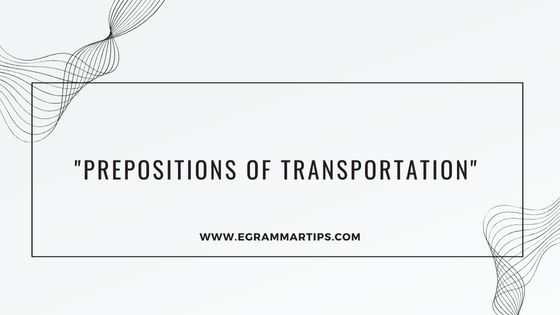
Prepositions of transportation are used to describe how someone travels or moves from one place to another. They help clarify the mode of transport and how the individual interacts with it.
1. By: Referring to the Mode of Transportation (General Use)
When talking about traveling in a general way without focusing on a specific vehicle or instance, we use by. It is commonly followed by the form of transportation.
By bus/train/plane/car: Used to describe traveling by any form of transport.
Example:
“She goes to work by bus.”
Example:
“We traveled by plane to New York.”
By foot: When walking.
Example: “I went to the park by foot.
Important notes:
No article (like “a” or “the”) is used between by and the mode of transport. For instance, “by car,” not “by a car.”
2. On: Used for Public or Large Transportation (When You Are Inside or On Top of It)
We use on when talking about traveling by larger forms of public transportation, such as buses, trains, ships, planes, bicycles, etc.
•On a bus/plane/train/ship: When referring to being inside or on these larger, usually public forms of transport.
Example: “They are on the bus now.”
Example: “He is traveling on a plane to London.”
•On a bicycle/motorbike/scooter: Used when the traveler is physically on top of the vehicle.
Example: “She is on her bike.”
Important notes:
On can also be used for animals like horses:
“She is on a horse.”
3. In: Used for Private or Smaller Vehicles
We use in when referring to smaller vehicles or when the person is inside a confined space.
In a car/taxi/helicopter/van: When the traveler is inside a smaller, usually personal, vehicle.
Example: “They are in a taxi.”
Example: “She is waiting in the car.”
Important notes:
Unlike on, in is for vehicles where the person is more enclosed (cars, taxis, helicopters, etc.).
4. Exceptions and Special Cases
•On foot vs. By foot: While “by foot” is correct, most commonly, people say “on foot.”
Example: “I’m going to the store on foot.”
•On board: This phrase is used to describe being on a ship or plane.
Example: “He’s on board the plane.”
5. Other Prepositions of Movement
Some prepositions, though not directly related to transportation modes, indicate movement from one place to another:
•To: Refers to the destination.
Example: “I’m driving to the airport.”
•From: Refers to the starting point of the journey.
Example: “We came from London.”
Examples in Sentences:
“He usually goes to work by bike but today he’s traveling in his car.”
“We traveled on a train across Europe.”
“She walked on foot to the park.”
By mastering these prepositions, you’ll be able to describe different modes of transportation accurately and fluently.